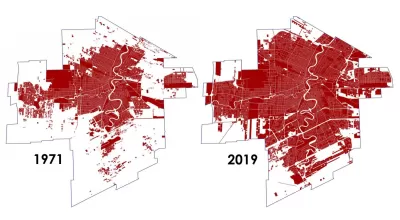Low density sprawl stretches the tax dollars of every resident. That fact could be used to support plans for more infill density, according to this article set in the city of Winnipeg, Manitoba.

"Planners at the City of Winnipeg are currently in the process of writing a residential infill strategy to guide new development in the city’s older neighbourhoods," according to a column by Brent Bellamy, creative director at Number Ten Architectural Group in Winnipeg.
The column makes one argument for why infill development would be a good thing for the city: sprawl costs too much.
A "jaw-dropping graphic" recently released by the city, compares the built-up area of Winnipeg in the 1970s to the Winnipeg of today. "In that time, the footprint of the city increased by 96 per cent, almost doubling, while the population increased by only 37 per cent. The conclusion was that the city is currently growing three times faster in area than it is in population," explains Bellamy.
That sprawl has economic repercussions, Bellamy writes: "Compared to 45 years ago, each individual Winnipegger is today responsible for the cost of maintaining almost 50 per cent more land area, and its corresponding services and infrastructure." Tax dollars stretched so far contributes to facts of life like potholes, rising taxes, and declining public service, according to Bellamy.
FULL STORY: City's expanding footprint has high cost

Planetizen Federal Action Tracker
A weekly monitor of how Trump’s orders and actions are impacting planners and planning in America.

Maui's Vacation Rental Debate Turns Ugly
Verbal attacks, misinformation campaigns and fistfights plague a high-stakes debate to convert thousands of vacation rentals into long-term housing.

Restaurant Patios Were a Pandemic Win — Why Were They so Hard to Keep?
Social distancing requirements and changes in travel patterns prompted cities to pilot new uses for street and sidewalk space. Then it got complicated.

In California Battle of Housing vs. Environment, Housing Just Won
A new state law significantly limits the power of CEQA, an environmental review law that served as a powerful tool for blocking new development.

Boulder Eliminates Parking Minimums Citywide
Officials estimate the cost of building a single underground parking space at up to $100,000.

Orange County, Florida Adopts Largest US “Sprawl Repair” Code
The ‘Orange Code’ seeks to rectify decades of sprawl-inducing, car-oriented development.
Urban Design for Planners 1: Software Tools
This six-course series explores essential urban design concepts using open source software and equips planners with the tools they need to participate fully in the urban design process.
Planning for Universal Design
Learn the tools for implementing Universal Design in planning regulations.
Heyer Gruel & Associates PA
JM Goldson LLC
Custer County Colorado
City of Camden Redevelopment Agency
City of Astoria
Transportation Research & Education Center (TREC) at Portland State University
Jefferson Parish Government
Camden Redevelopment Agency
City of Claremont





























